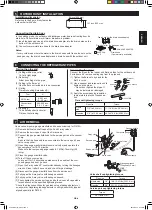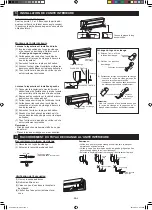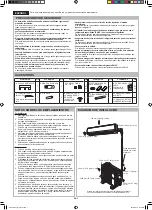
GB-4
ENGLISH
Flaring the pipe end
(1) Cutting with a pipe cutter
Cut at a right angle.
(2) Deburring
Allow no cuttings in the pipe.
(3) Putting in the flare nut
Use the flare nut included in the accessories.
(4) Flaring
Flare processing dimensions(A)
Tool
A
R410A tool
0-0.02 inch
(0 - 0.5 mm)
Conventional
tool
0.04-0.06 inch
(1.0 - 1.5 mm)
(5) Checking
To be flared perfectly circular.
Flare nut not missing.
6 CONNECTING THE REFRIGERANT PIPES
7 AIR REMOVAL
90°
A
Lo
Hi
Use a vacuum pump, gauge manifold and hoses exclusively for R410A.
(1) Remove both valve shaft caps of the 2 and 3-way valves.
(2) Remove the service port cap of the 3-way valve.
(3) Connect the gauge manifold hose to the service port and the vacuum
pump.
Be sure that the hose end to be connected to the service port has a
valve core pusher.
(4) Open the gauge manifold low-pressure valve(Lo) and operate the
vacuum pump for 10-15 minutes.
Make sure the compound gauge reads -0.1 MPa(-76 cmHg)(-30
in.Hg).
(5) Close the gauge manifold valve.
(6) Turn off the vacuum pump.
Leave as it for 1-2 minutes and make sure the needle of the com-
pound gauge does not go back.
(7) Open the 2-way valve 90° counterclockwise by turning the hexagon
wrench. Close it after 5 second, and check for gas leakage.*
(8) Disconnect the gauge manifold hose from the service port.
(9) Fully open the 2-way valve with hexagon wrench.
(10) Fully open the 3-way valve with hexagon wrench.
(11) Firmly tighten the service port cap and both valve shaft caps with a
torque wrench at the specified tightening torque.
* Check the pipe connections for gas leak using a leakage detector or
soapy water. Regarding leakage detector, use high-sensitivity type de-
signed specially for R410A.
Gauge manifold
Compound gauge
Vacuum pump
Service port cap
3-way valve
Valve shaft cap
Valve shaft cap tightening torque
Pipe size
Torque
Liquid side
1/4"
14.8-15.5 ft·lbs (20-21 N · m)
Gas side
5/8"
22.1-23.6 ft·lbs (30-32 N · m)
Service port cap tightening torque
Torque
5.9 ft·lbs(8 N · m)
Installation dimension
Referring to the figure, firmly fasten the
outdoor unit with bolts.
5 OUTDOOR UNIT INSTALLATION
Connecting the drain hose
In the heating mode, the outdoor unit discharges water due to defrosting from its
drain hole. Perform drain work if water drops are a problem.
(1) Insert the base pan cap and the drain hose adapter into the drain holes on the
bottom of the outdoor unit.
(2) Connect commercial drain hose to the drain hose adapter.
Notes:
• In very cold areas where the water in the drain hose could freeze, do not use the
base pan cap, the drain hose adapter and a drain hose with the outdoor unit.
Drain hose
(Commercially available)
Drain hole (for the drain hose adapter)
6
DRAIN HOSE ADAPTER
2-way valve
Hexagon wrench
(Diagonally 5 mm)
OPEN
Service port
CLOSE
24 inch (609 mm)
15.7 inch (399 mm)
Drain hole (for the base pan cap)
7
BASE PAN
CAP
Connecting the pipes
Connect the pipes for the indoor unit first and then for the outdoor unit.
For indoor unit, remove sealing cap from the pipe end.
(1) Tighten the flare nuts by hand for the
first 3-4 turns.
(2) Use a spanner and torque wrench to
tighten up the pipes.
• Do not over tighten the pipes. It
may be deformed or damaged.
(3) Apply the accompanying insulation
to pipe joints to prevent condensa-
tion.
Flare nut
Spanner
Torque wrench
Flare nut tightening torque
Pipe size
Torque
Liquid
side
1/4" (ø 6.35 mm)
11.1-14.8 ft·lbs (15-20 N·m)
Gas side
5/8" (ø 15.88 mm)
44.3±47.9 ft·lbs (60-65 N·m)
8
INSULATION
AYX36RU_IM_3_lang.indb 4
2014-09-12 07:59:34
Содержание AE-X36RU
Страница 20: ...AYX36RU_IM_3_lang indb 7 2014 09 12 07 59 44 ...






































